This post may contain affiliate links. Please read our disclosure policy.
Learn how to make buffalo sauce from scratch at home! This fermented chili sauce requires just 7 ingredients and tastes just like the real one, if not better! You are going to love this Frank’s RedHot copycat!

Over the years, a bunch of you have asked me where to find Frank’s RedHot sauce. So, instead of telling you where to find it, I’m going to show you how to make it at home!
After carefully examining the ingredients used in the store-bought version and testing several batches, adjusting the ingredient ratio and fine-tuning the process, I’m proud to say that this homemade version tastes incredibly close to the real thing.
It has that perfect balance of tangy and spicy flavors, with buttery and subtly fruity notes, just like the classic!
Quick note: I have recently re-worked and updated this recipe to make it truly fermented (unlike before), and it now tastes even closer to the original.
⭐️ What Makes It So Good
Naturally fermented.
What’s unique about my buffalo sauce is that it’s naturally fermented. So it’s not just flavorful, it’s also packed with probiotics! Thanks to the magic of lactofermentation, the cayenne peppers take on a natural sweetness and develop deep, complex flavors as they ferment in the brine.
Simple and made with minimal ingredients.
Making your own chili sauce is way easier than you might think! All you need are 7 simple ingredients and a few basic tools: a glass jar, a blender, and a fine-mesh sieve.
The only part that takes a little time is the fermentation. But even that is pretty quick. Depending on the temperature, it will take no longer than 3 to 7 days for the peppers to be ready. After that, just blend everything together, strain it, and you are done!
How does it compare to the original?
After testing side by side more times than I would like to admit, and probably slurping down a quarter cup of sauce, I would say that this homemade version is about 95% identical to the original. The only difference is that it’s slightly less spicy. Tanginess, saltiness, and flavor are all on point.
📘 What Is Buffalo Sauce
Buffalo sauce, also known as buffalo wing sauce, is a hot sauce made from cayenne peppers, vinegar, butter, and garlic. The name “Buffalo” comes from the city where the sauce was invented.
This sauce is typically used to make chicken wings, but it can also be used in dipping sauces, marinades, soups, and other dishes.
What is the difference between Frank’s RedHot Original and Frank’s Wings Buffalo?
The only difference is that Frank’s Buffalo Wings sauce includes butter flavor and paprika. This recipe replicates the Buffalo Wings sauce version.
🌶 Ingredient Notes
You can find below a few notes on the ingredients you will need. For the complete measurements, please refer to the recipe card at the end of this page.
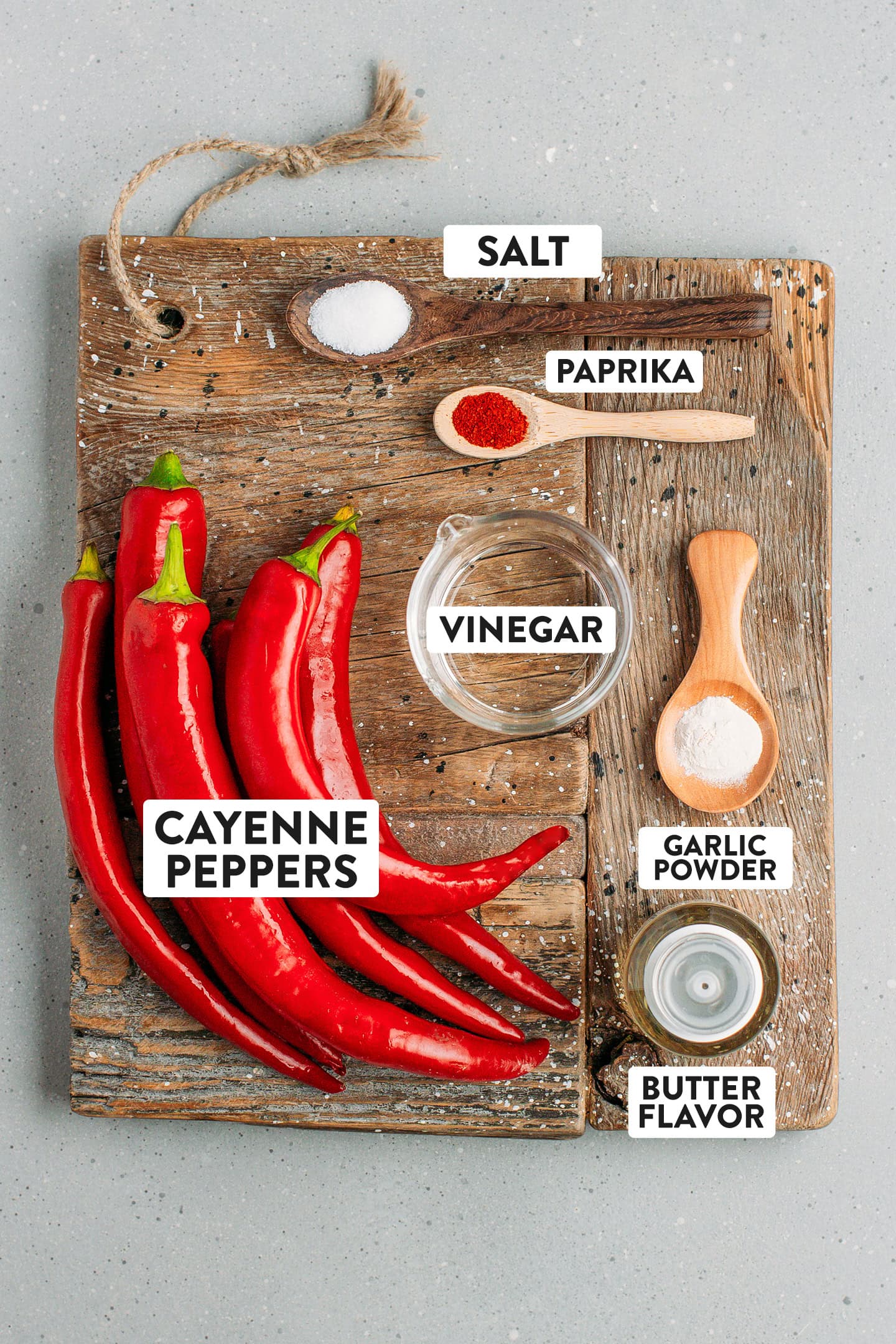
Cayenne peppers
The base of the sauce consists of fresh red cayenne peppers. This type of pepper is roughly 7 inches (18 cm) long and has a vibrant red color. It has a spiciness of about 40,000 Scoville Heat Units, which is considered moderately hot.
Where to buy: Depending on where you live, you might be able to find cayenne peppers in most well-stocked produce supermarkets year-round. In Europe, I have always found it during summer, though.
How to pick them: Skip the soft, wrinkly ones as those are old peppers. Instead, look for peppers with crisp, smooth skin.
Salt
Salt is essential for making the brine in which the peppers will ferment for a few days. You will also need to add extra salt to season the final sauce.
Vinegar
Buffalo sauce is very tangy, so you will need either regular white vinegar or white rice vinegar. The vinegar is blended with the peppers AFTER fermenting them. Otherwise, that large amount of vinegar would prevent any fermentation.
Garlic
You can use garlic powder (as noted in the recipe) or blend the sauce with one clove of garlic. The latter results in a deeper garlicky flavor but may slightly decrease the shelf life of the sauce.
Butter flavor
To achieve the well-known flavor of Frank’s RedHot Sauce, you can add a few drops of butter flavor. This is entirely optional, and the sauce will still taste great without it. It just adds that subtle buttery flavor that makes the original version so special.
Xanthan gum (optional)
After blending and straining, the sauce will be pretty liquid. A bit thinner than the original. Hence, if you want to match the same consistency, you will need to thicken it. The easiest way is to blend the strained sauce with about half of a teaspoon of xanthan gum, which will give it a slightly thicker consistency.
Note: Another option to thicken the sauce is to combine it with a teaspoon of cornstarch and heat it until it comes to a simmer. The downside of this option is that it will kill the probiotics and doesn’t freeze well.
🥣 How to Make It

How to Handle Hot Peppers
Before you get started, be aware that chili peppers can easily irritate your skin and/or eyes, so it’s worth taking a few precautions:
- Wear gloves: I highly recommend using gloves when handling the peppers. It will prevent the pepper’s juice and oil from going under your nails or entering any tiny cuts you might have on your hands.
- Do not touch your face: Do not touch your face or rub your eyes unless you have thoroughly cleaned your hands – otherwise it’s going to hurt!
- Use a face mask: Although not mandatory, I also suggest wearing a disposable face mask when blending the peppers. The spicy fumes can make you cough or irritate your throat.
With that being said, no need to be scared! As long as you are careful, you will be totally fine!
1. Prepare the peppers
- Clean the peppers. Run the peppers under cold water and pat them dry using kitchen paper towels.
- Remove the seeds and stems. Next, chop off the stems of the peppers. Using a thin and sharp knife, slice the peppers in half lengthwise. Remove the seeds and the long, bright strips (Capsaicin Glands) and discard them.
- Chop them. Chop each pepper into 1-inch (2.5 cm) thick slices. Set aside.
2. Let them ferment
Next comes the fun part: the fermentation! Not only does it make the peppers easier to digest, but it also increases the shelf life of the sauce. Fermentation also allows the sauce to develop more complex flavors, so do not skip it!
- Make the brine. Add the salt to a small bowl. Pour in warm water and stir until the salt dissolves. Allow the brine to cool for a few minutes, or until it is no longer warm.
- Transfer the peppers to a jar. Add the chopped peppers to a clean 32 oz (1 liter) glass jar.
- Cover with the brine. Then, pour the brine into the jar containing the peppers. You want the peppers to be fully immersed. They should not be floating. To do so, you can use either a fermentation weight or a freezer bag filled with water.
- Let it ferment. Loosely cover the jar with plastic wrap and allow the peppers to ferment at room temperature in a dark place for 3-7 days. After a couple of days, you should start to see bubbles in the jar. This means the fermentation has begun! 2-4 days later, the bubbles will have disappeared and the brine should look cloudy. At this point, the peppers won’t have a raw smell and will have a sweeter, more pleasant flavor.
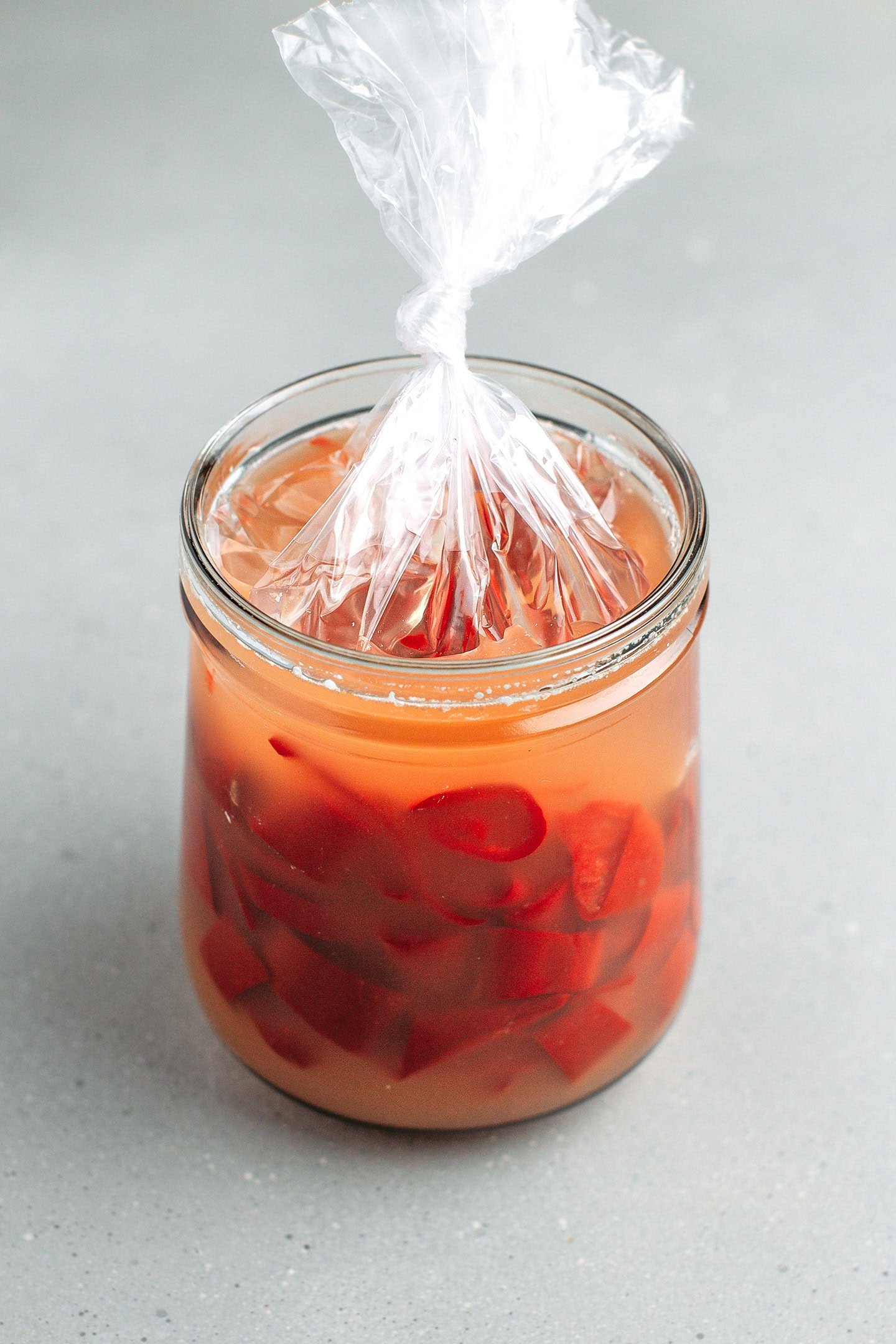
3. Blend and strain
- Drain. Once the peppers have fermented, drain them using a colander and discard the brine.
- Blend. Transfer the drained peppers to a blender. Add the vinegar, paprika, garlic powder, butter flavor if using, and salt. Blend on high speed for about 1 minute, or until the mixture is liquid and smooth.
4. Strain
- Strain the mixture. To achieve a smoother consistency, strain the blended sauce through a fine-mesh sieve. You can then transfer the sauce to a clean jar or a hot sauce bottle!
What to do with the leftover pulp? You shouldn’t end up with a lot of leftover pulp after straining, but enough to make a simple chili paste. To do so, fry one minced shallot, 2 cloves of garlic, and 1 tablespoon of minced lemongrass for 3-4 minutes. Add the chili pulp and cook for one more minute. You can then use this paste in curries, stir-fries, soups, and other dishes.
Thickening the sauce
After straining, the sauce will be very liquid. This is normal. To achieve the same consistency as Frank’s RedHot, you can add 1/2 teaspoon of xanthan gum to the filtered sauce and blend again.
📔 Tips
Do not decrease the amount of salt.
The salt plays a crucial role in the brine, as it prevents the development of harmful bacteria while promoting the growth of beneficial bacteria. So do not decrease the amount of salt or increase the amount of water. The ratio I am giving is specifically designed for this recipe and yields a brine with approximately 2.5% salt.
If you prefer, you can increase the salt to up to 2 teaspoons, which brings the brine closer to 3.5%. Just keep in mind that a higher salt level will slow down the fermentation process.
Adjust the fermenting time.
Depending on the temperature, you may need to let the peppers ferment for a longer period. I usually let mine ferment for 7 days or about 4 days during the hotter days. I didn’t notice any significant difference in flavor if it’s fermented for longer than that.
🌿 Variations
Here are some ways you can customize the sauce to your liking:
Add some herbs:
Feel free to add bay leaves, thyme, peppercorns, mustard seeds, or coriander seeds to the jar of peppers to add floral notes to the sauce.
Make it spicier:
Want it spicier? Add 3 to 5 Bird’s eye chilies (also known as Thai chilies) to the jar and let them ferment with the cayenne peppers.
Go chunky:
For a thicker, more textured sauce, just skip the straining step!
🌮 Where to Use It
This buffalo sauce is super versatile and can be used in a multitude of dishes. You can use it:
- As a dip: With fries, roasted vegetables, tempura, or any deep-fried food. You can even mix it into hummus or other dips for a spicy kick.
- As a marinade: Use it to marinate tofu, tempeh, vegan chicken, or seitan.
- In casseroles and soups: Stir a few tablespoons of buffalo sauce into baked dishes or soups to bring the heat up!
- To make dressings: Combine it with tahini or mayonnaise to create a creamy yet spicy salad dressing.
❄️ Storing and Freezing
- To store: You can store the sauce in the refrigerator for up to 1 month.
- To freeze: Transfer the sauce to a small freezer-safe bag and freeze for up to 3 months. Thaw overnight in the refrigerator.
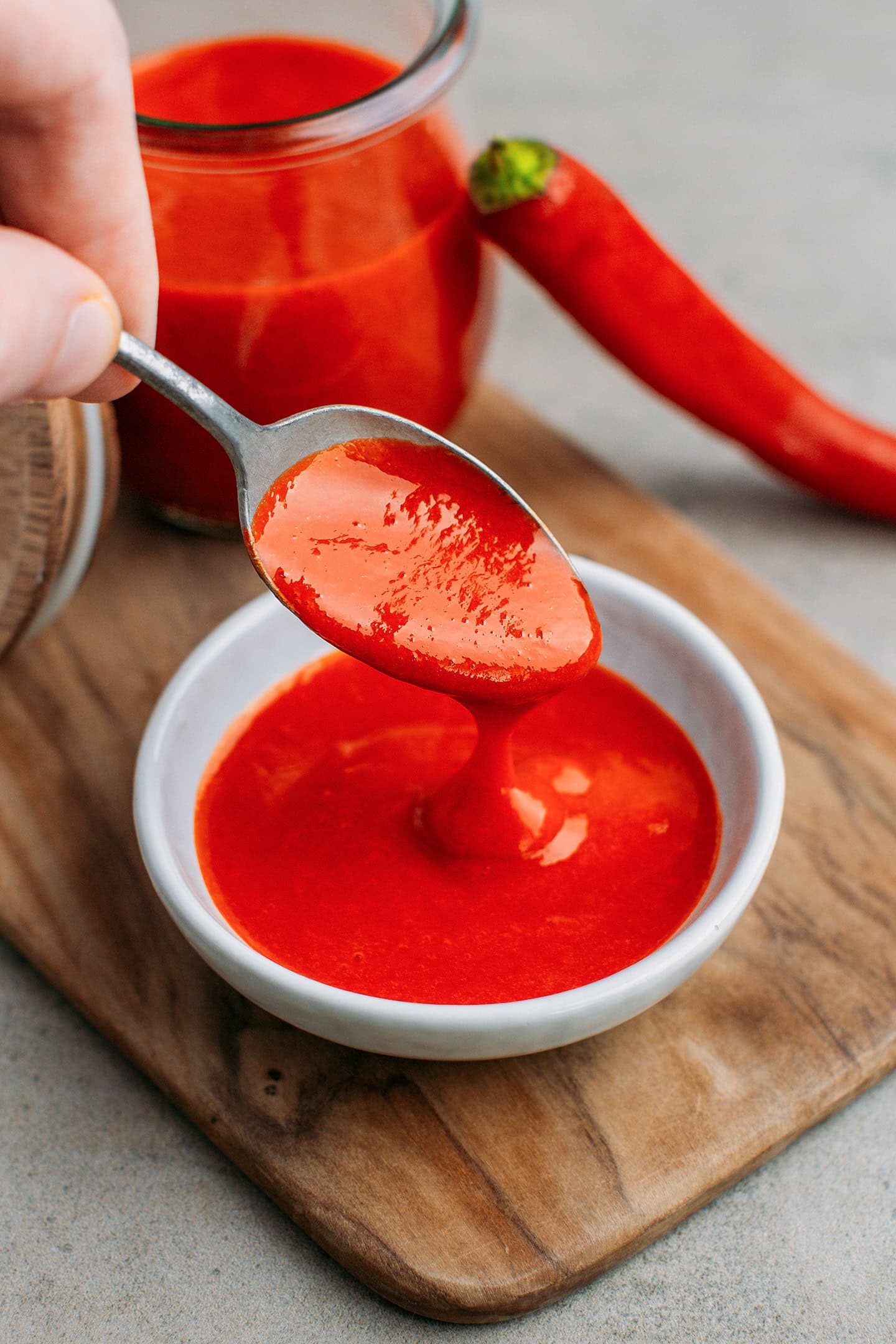
💬 FAQ
For the best result, I suggest using a glass jar. Ensure it’s perfectly clean. You can sterilize it by baking the empty jar in a 430°F (220 °C) preheated oven for 15-20 minutes. Allow the jar to cool completely before using.
You shouldn’t see any more bubbles in the jar, and the brine should look cloudy.
What you see is called Kahm, which is a harmless yeast. It generally appears when your peppers float above the brine. You can simply scoop the top and discard it. Next time, try keeping the peppers fully submerged using a fermentation weight or a freezer bag filled with water, which you place over the peppers.
If you like Frank’s RedHot sauce, you are going to love this homemade buffalo sauce recipe! Just remember that this sauce is slightly sweeter and a bit less spicy than the original, which I actually think makes it even better!
🥫 More Homemade Sauces
⭐️ Did you like this recipe? Let us know in the comments below, and tag us on Facebook, Instagram, or Pinterest!
Note: This recipe was first released in March 2019 and updated with new process shots and detailed instructions in July 2025.


Want to Save This Recipe?
Enter your email below & we’ll send it straight to your inbox! Plus, you will receive new recipes every week!
I’d like to receive more tips & recipes from Full of Plants.
This site is protected by reCAPTCHA and the Google Privacy Policy and Terms of Service apply.

Homemade Fermented Buffalo Sauce (From Scratch!)
Equipment
Ingredients
Brine
- 1 and 1/2 tsp (6 g) salt
- 1 and 1/2 cup (360 ml) water
- 10 ounces (300 g) red cayenne peppers (about 12 peppers)
The Rest
- 1/3 cup (80 ml) white vinegar or white rice vinegar
- 1/4 tsp paprika
- 1/4 tsp garlic powder
- 1/4 tsp butter flavor optional
- 1/4 tsp salt
Instructions
- Before starting: Be aware that chili peppers can easily irritate your skin and/or eyes, so I recommend using gloves when handling them.
- Make the brine. Add the salt to a small bowl. Pour in warm water and stir until the salt dissolves. Allow the brine to cool for a few minutes, or until it is no longer warm.
- Clean the peppers. Run the peppers under cold water and pat them dry using kitchen paper towels.
- Remove the seeds and stems. Next, chop off the stems of the peppers. Using a thin and sharp knife, slice the peppers in half lengthwise. Remove the seeds and the long, bright strips (Capsaicin Glands) and discard them.
- Chop them. Chop each pepper into 1-inch (2.5 cm) thick slices.
- Transfer the peppers to a jar. Add the chopped peppers to a clean 32 oz (1 liter) glass jar.
- Cover with the brine. Then, pour the brine into the jar containing the peppers. You want the peppers to be fully immersed. They should not be floating. To do so, you can use either a fermentation weight or a freezer bag filled with water.
- Let it ferment. Loosely cover the jar with plastic wrap and allow the peppers to ferment at room temperature in a dark place for 3-7 days. After a couple of days, you should start to see bubbles in the jar. This means the fermentation has begun! 2-4 days later, the bubbles will have disappeared and the brine should look cloudy. At this point, the peppers won’t have a raw smell and will have a sweeter, more pleasant flavor.
- Drain. Once the peppers have fermented, drain them using a colander and discard the brine.
- Blend. Transfer the drained peppers to a blender. Add the vinegar, paprika, garlic powder, butter flavor if using, and salt. Blend on high speed for about 1 minute, or until the mixture is liquid and smooth.
- Strain the mixture. To achieve a smoother consistency, strain the blended sauce through a fine-mesh sieve. Optional: For the same consistency as Frank’s RedHot, you can add 1/2 teaspoon of xanthan gum to the filtered sauce and blend again.You can then transfer the sauce to a clean jar or a hot sauce bottle!
- You can store the sauce in the refrigerator for up to 1 month.
Notes
Do not decrease the amount of salt.
The salt plays a crucial role in the brine, as it prevents the development of harmful bacteria while promoting the growth of beneficial bacteria. So do not decrease the amount of salt or increase the amount of water. The ratio I am giving is specifically designed for this recipe and yields a brine with approximately 2.5% salt. If you prefer, you can increase the salt to up to 2 teaspoons, which brings the brine closer to 3.5%. Just keep in mind that a higher salt level will slow down the fermentation process.Adjust the fermenting time.
Depending on the temperature, you may need to let the peppers ferment for a longer period. I usually let mine ferment for 7 days or about 4 days during the hotter days. I didn’t notice any significant difference in flavor if it’s fermented for longer than that.Nutrition

About the Author
Thomas Pagot is the founder, photographer, and recipe developer behind Full of Plants. He created the blog in 2016 as a personal cookbook for vegan recipes. Through years of recipe development, Thomas has successfully grown Full of Plants into a trusted resource for plant-based recipes.



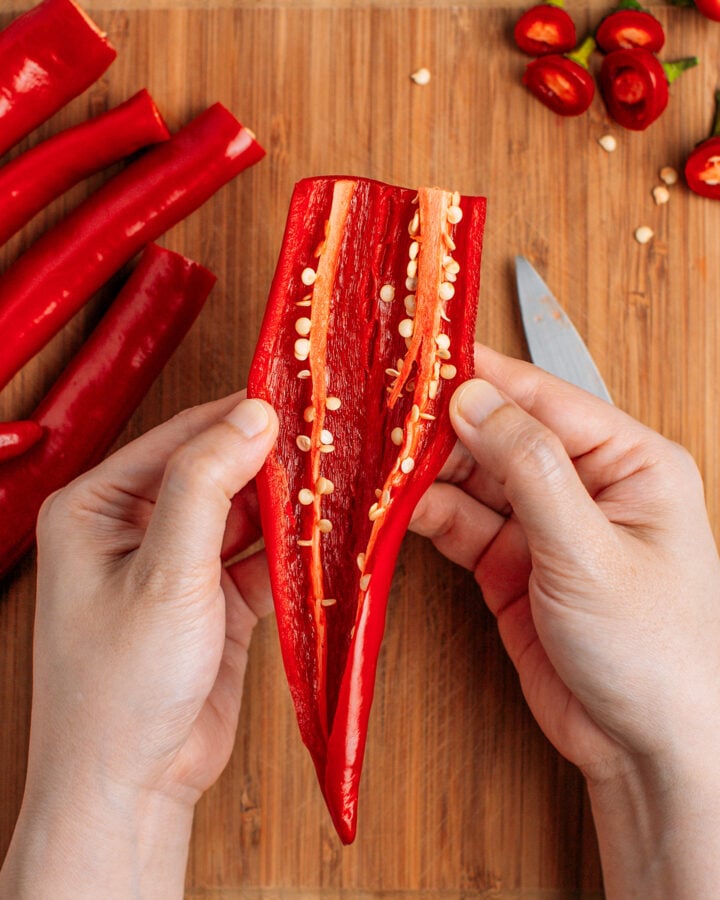
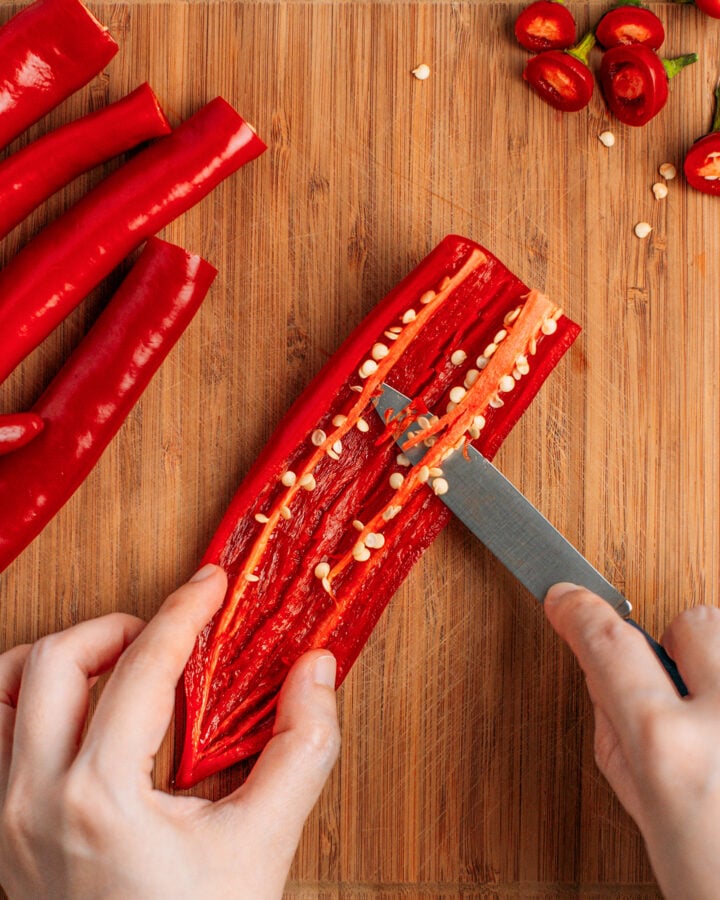
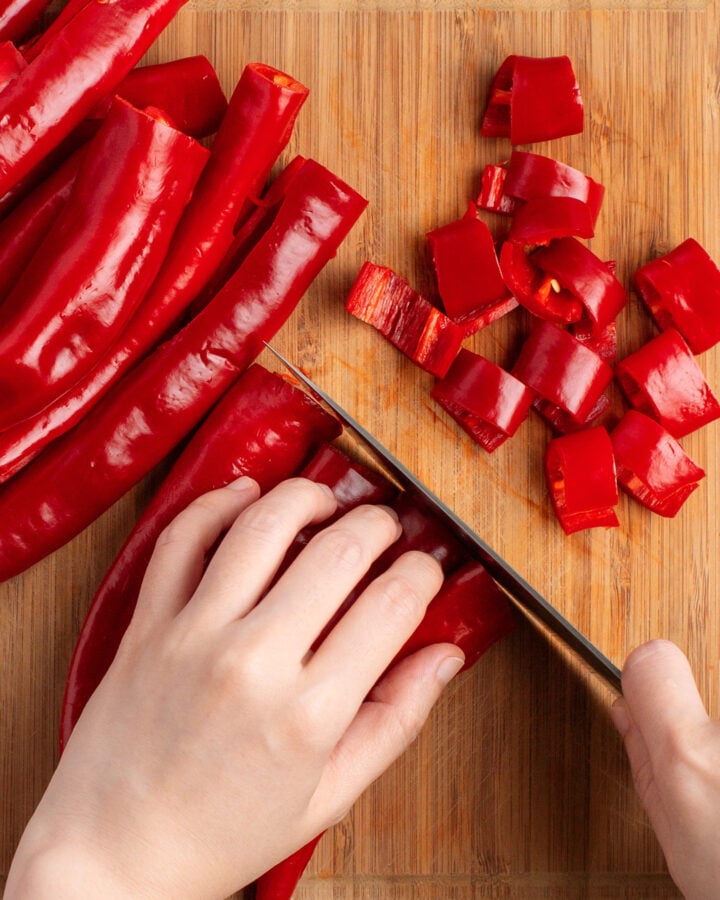
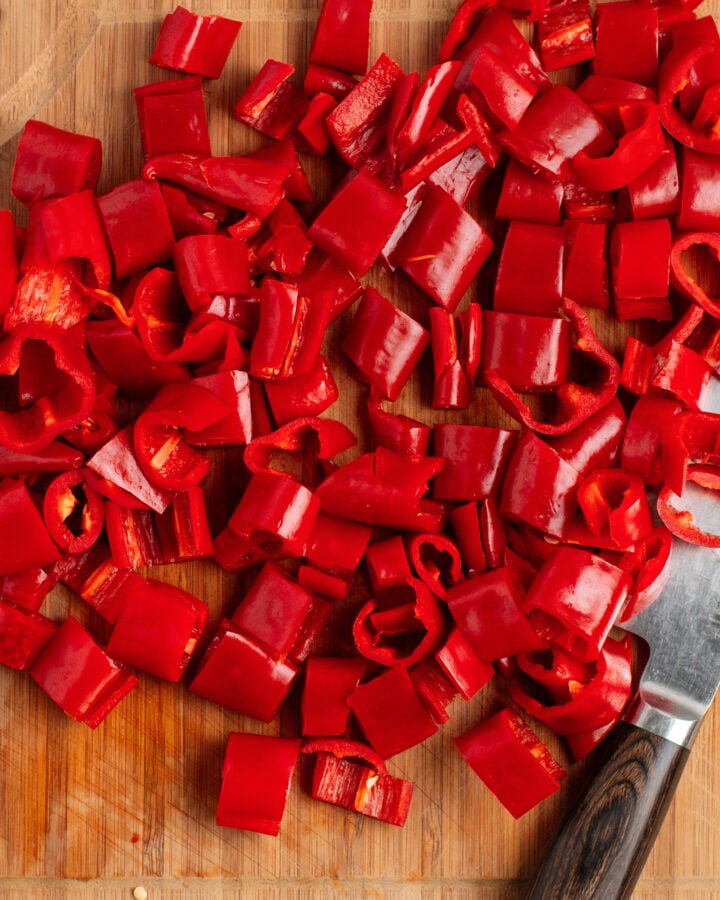
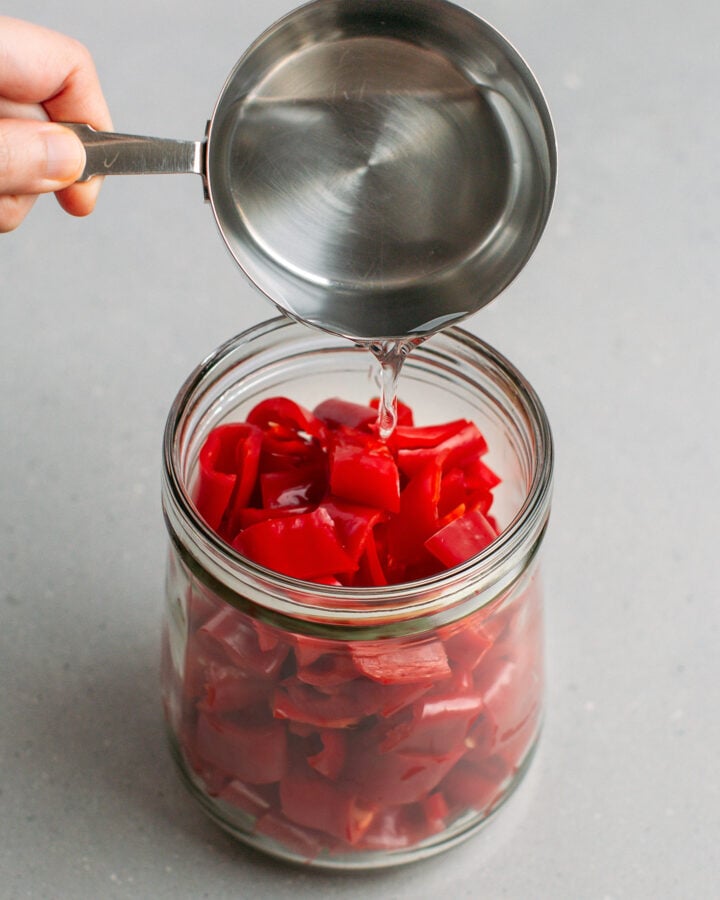
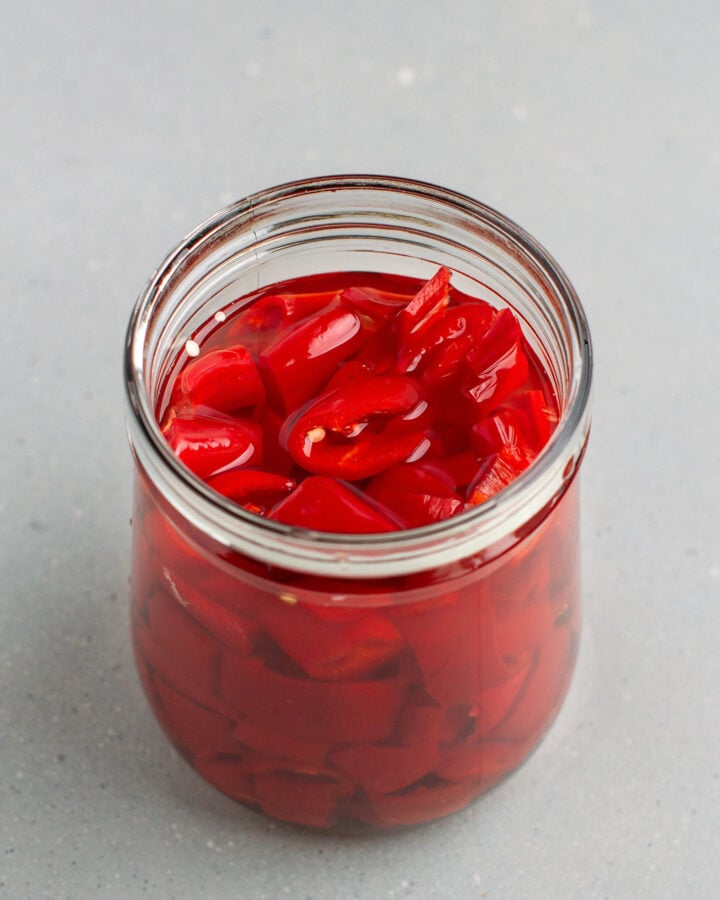
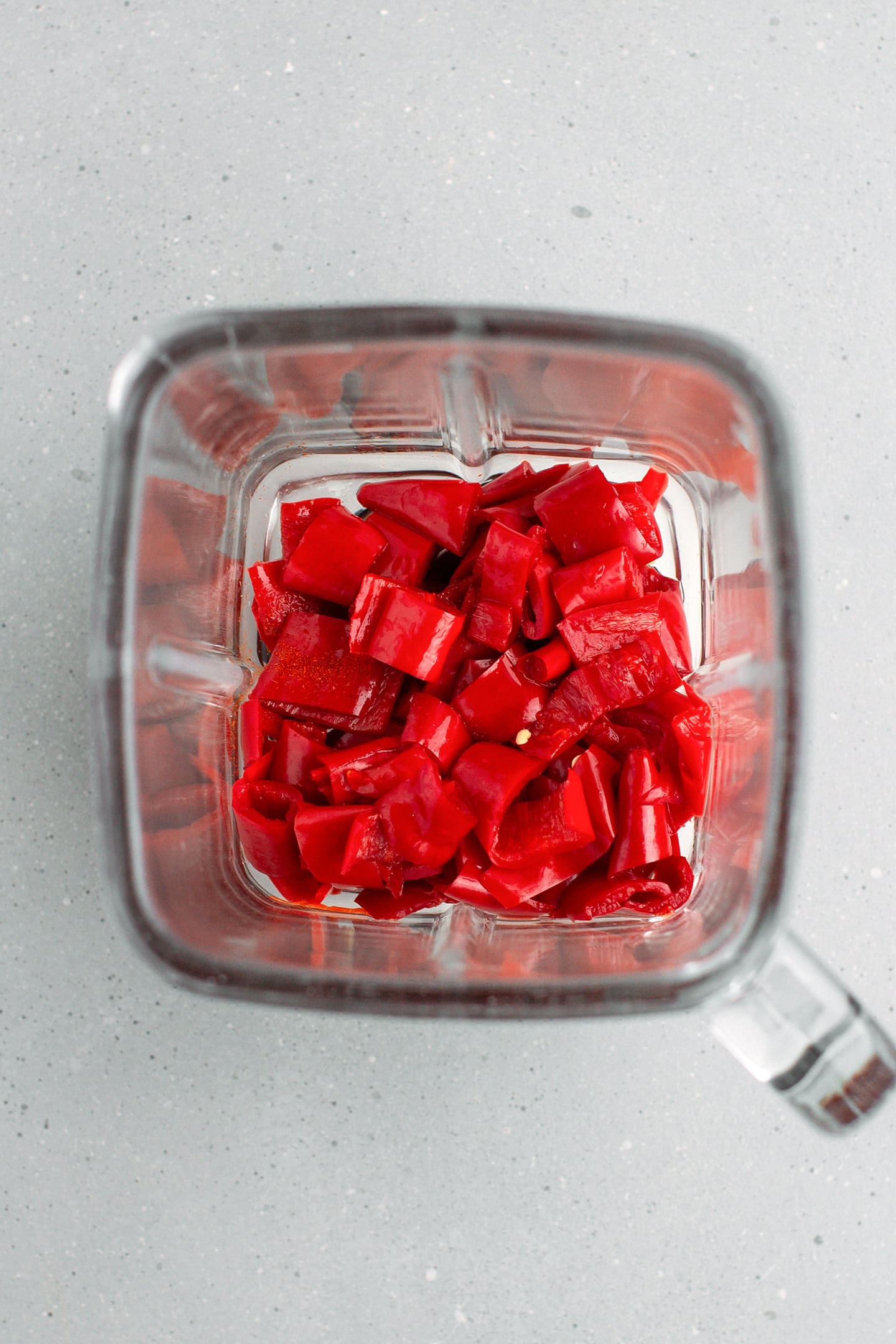
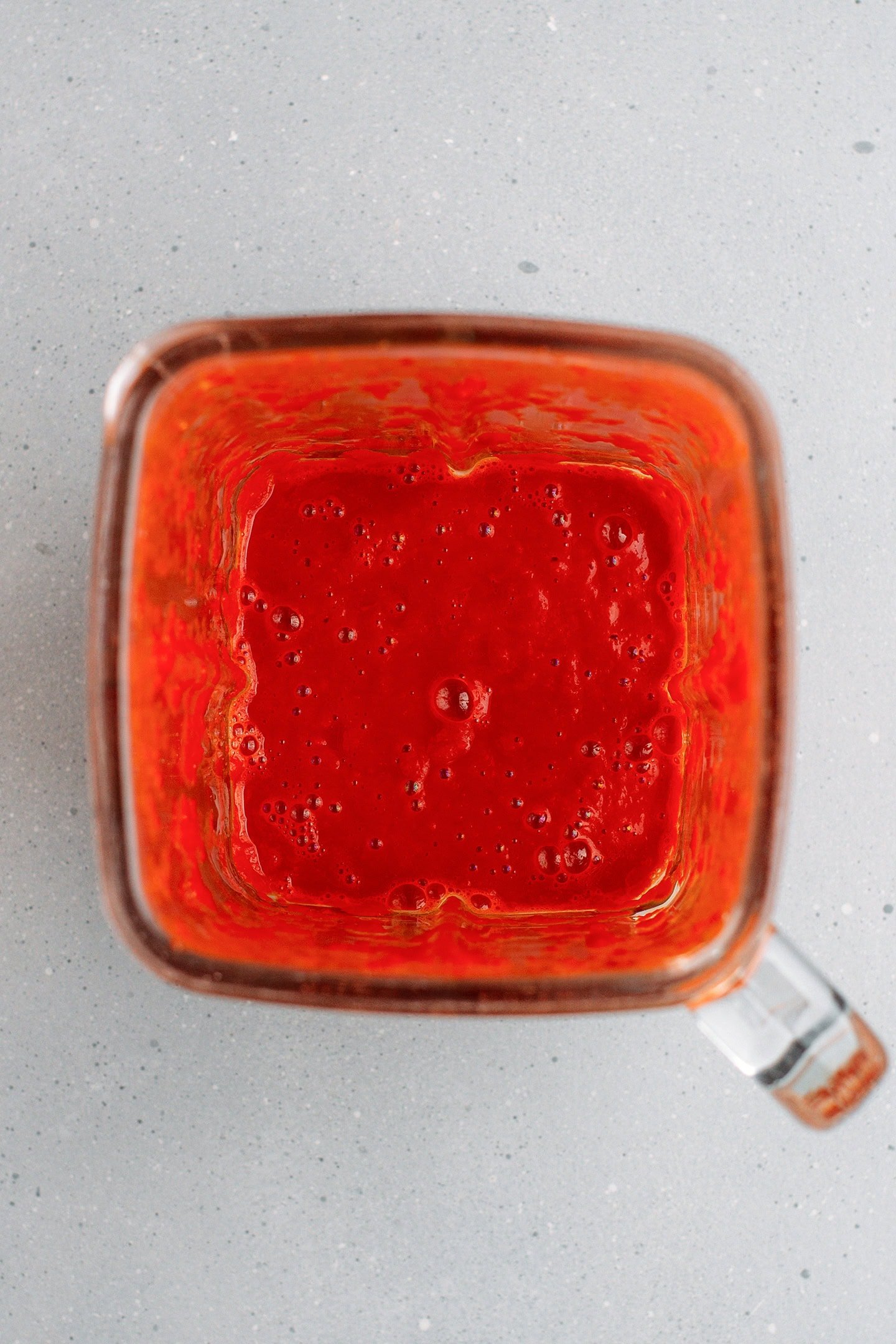
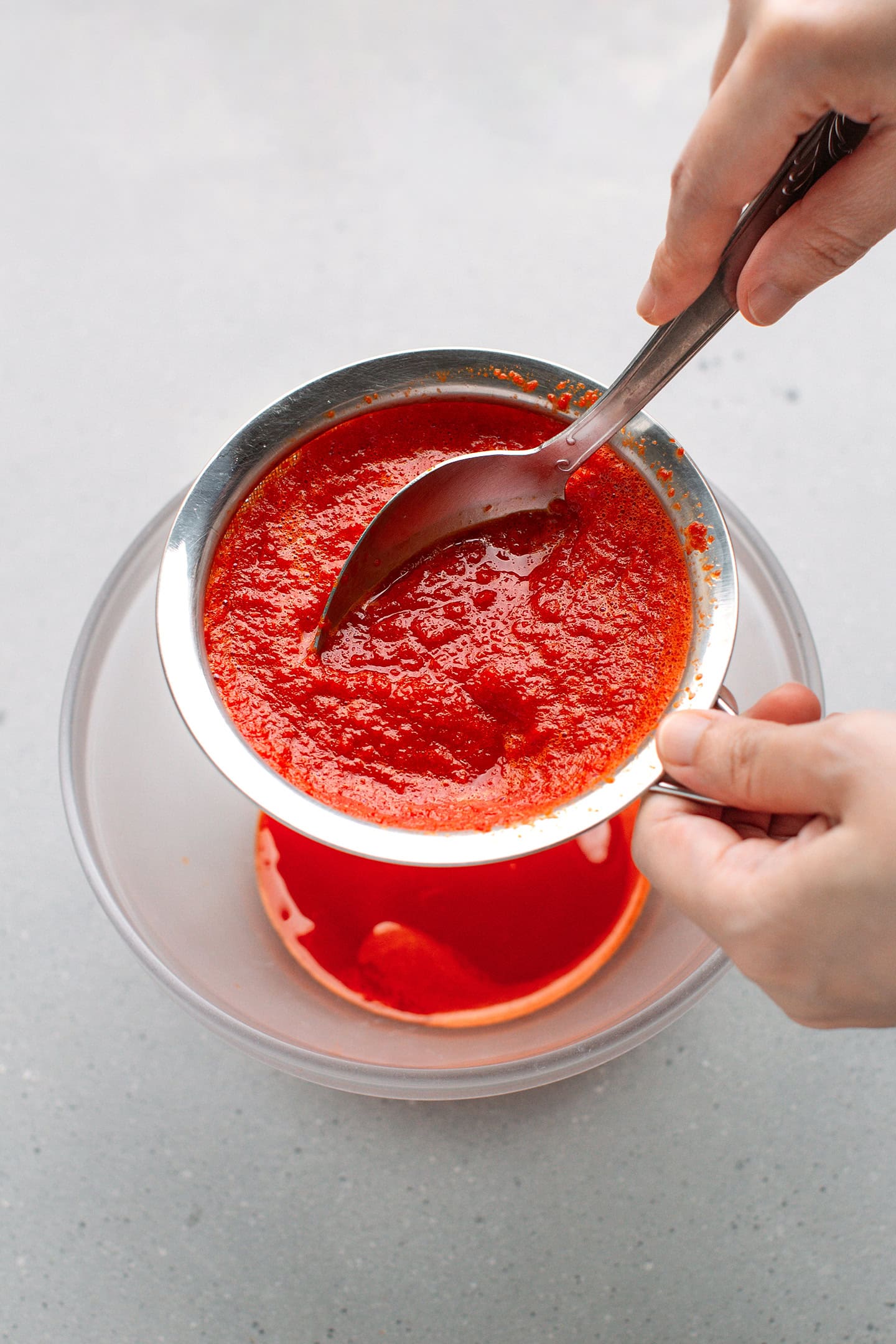
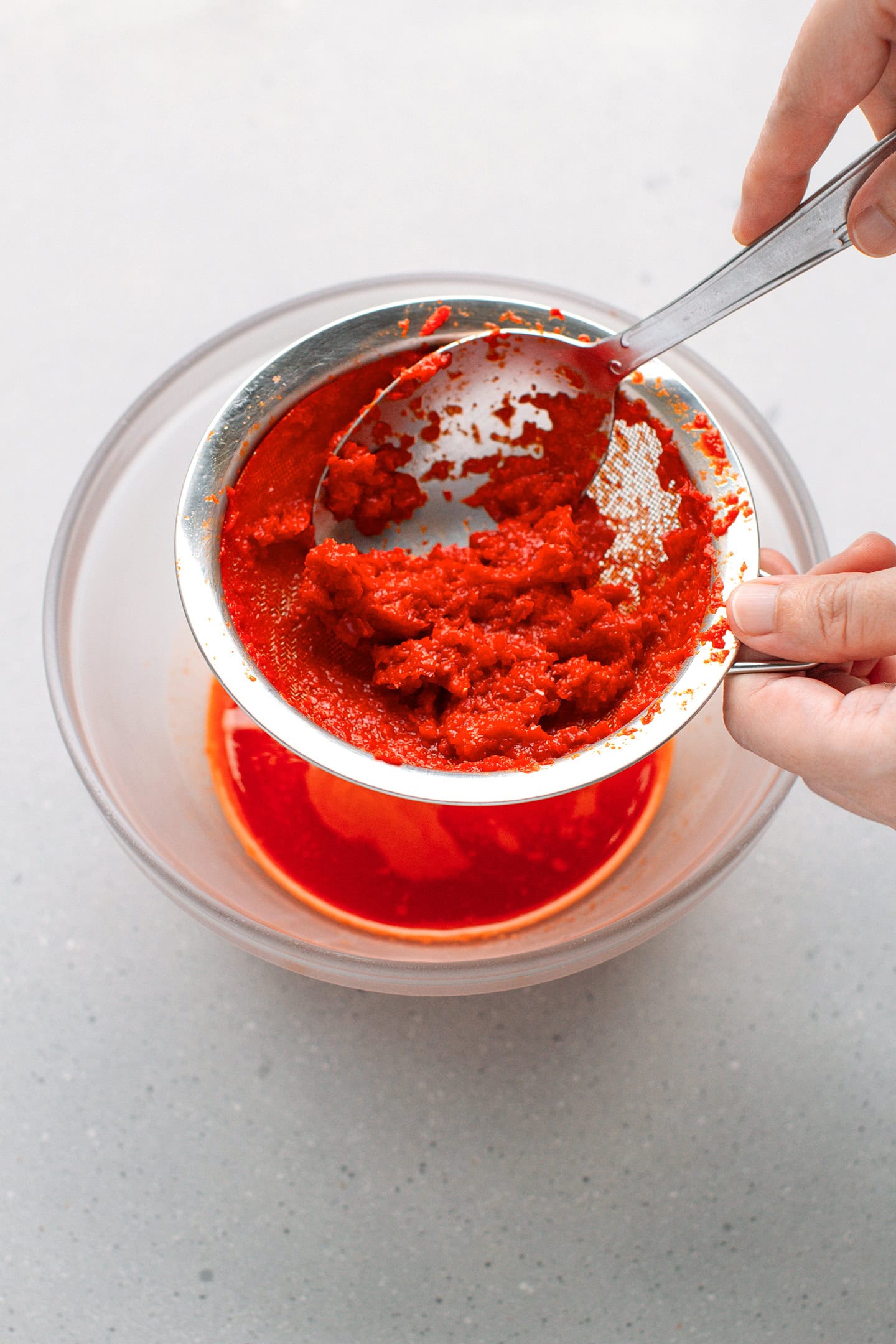
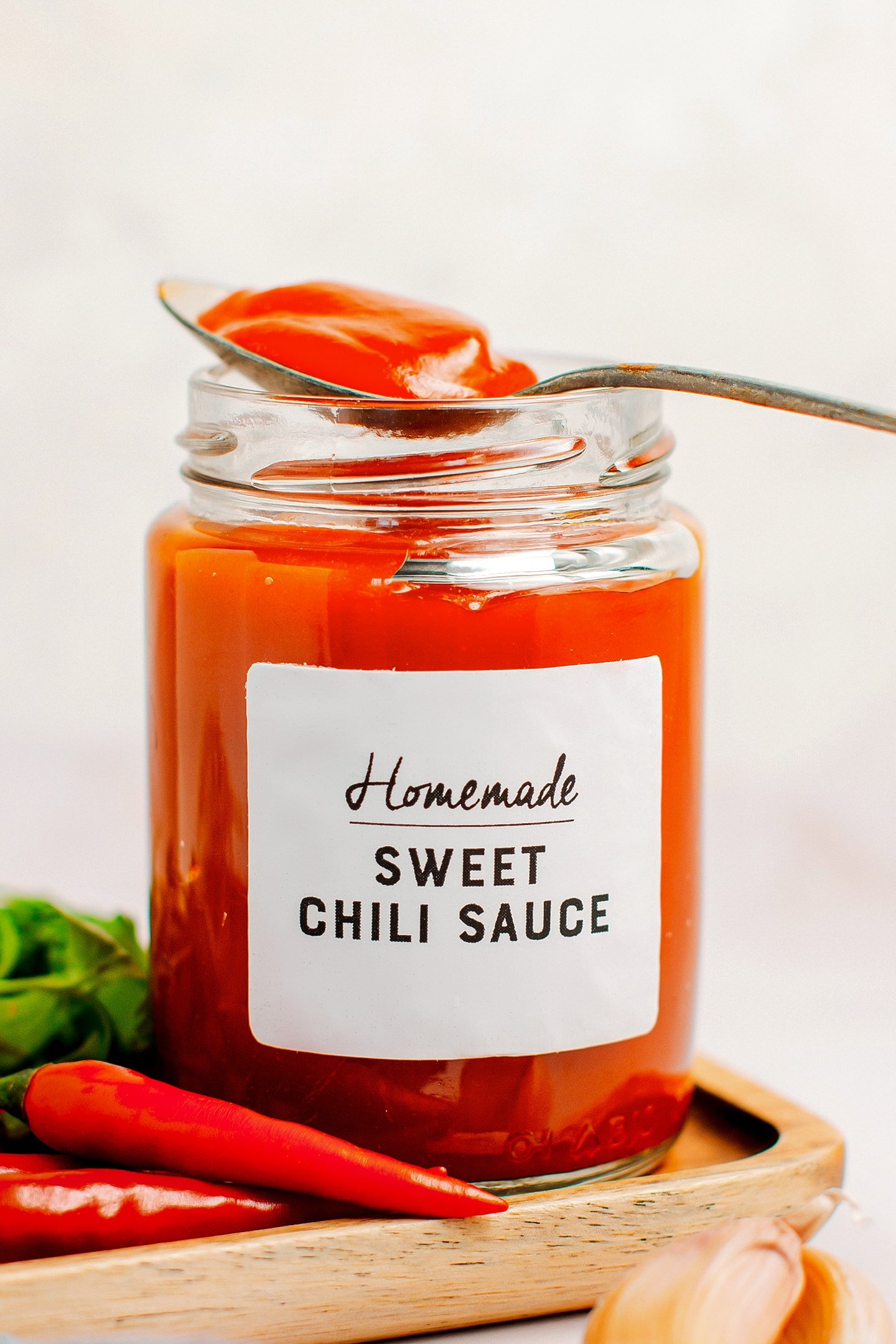
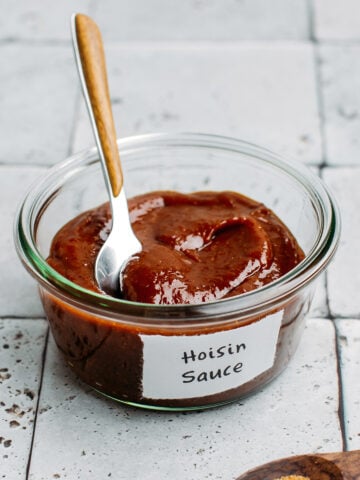

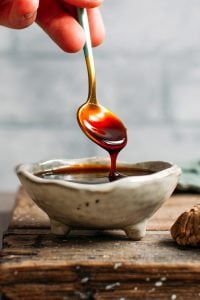
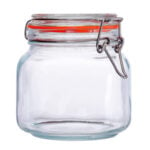
Leave a Comment
We used jalapenos since we had an abundance in our garden. Followed the rest of your recipe as written. We found the sauce was very liquidy. Is there something that we could do to make it more of a Frank’s consistency? Your instructions were well written.
Thanks for your feedback Jan.
For a thicker sauce, you may try using a bit less vinegar/water (and adjust the saltiness too). Another options would be to use a cheesecloth to drain some excess liquid.
Hi there! Would it be okay to use white wine vinegar instead of white rice vinegar? TIA!
Yes, it should work too!
Thank you Thomas. I am a trained cook since early age. It is my passion following a tradition of at least 10 generations. Some members became professional. I cooked in fancy restaurants and loved it, except my feet.
Your recipe is fail proof. It is tasty and easy. Sometimes when I want it very spicy I roast a few Japanese peppers (chile the arbol) after I lightly toasted them on the pan (brown, never dark) I shred them in the processor, add them, and it works like a charm and is very predictable.
Thanks for your feedback Isis, I really appreciate it 🙂
Missing garlic. Frank’s Red Hot Sauce has garlic in it.
But otherwise looks nice and spicy and tasty.
You could definitely add some garlic powder 😉
This being a fermented sauce, surely you should add the vinegar after the fermentation period as it will kill the bacteria necessary for fermentation?
Correct. It’s not actually a true fermentation.
Hey! Love the recipe!
Just wanted to know if 7 days wait is a must? I mean how much less can I wait?
Hey,
I would say 5 days at least. Letting the chili ferment not only improves flavor, but it also helps the sauce keep longer.
Why use cheesecloth to cover it instead of a lid? I am seeing other fermentation recipes that call for a lid. Just wondering, thanks!!
I prefer to use a cheesecloth to let some of the gas produced during the fermentation escape. Using a lid is okay though.
Hi Thomas, I’m looking at making this, you’ve mentioned that the butter flavour is optional. I live in Australia and we don’t have this kind of thing here, could I use regular butter when blitzing so it emulsifies??
Hi Kim,
You could use vegan butter, just be aware that it might decrease a bit the shelf life of the sauce.
Hi Thomas,
Do you think this will freeze well?
Thanks! Excited to try!
Hi Jodi,
I think it will freeze well, but it keeps for weeks in the refrigerator.
What butter flavor do you use? I’ve tried McCormick but I didn’t like it.
I’m using a brand from Europe so I’m afraid it’s not available in the US. But I’m sure there are other great ones.
Bonjour Thomas,
Ou trouver des piments de cayennes frais en France ?
Merci beaucoup !
Brice
Bonjour Brice,
Je les trouvent au supermarché, ce sont de longs piments rouges.
Made this and it’s super tasty thankyou! But is it actually a fermented sauce? With the vinegar it’s more of a pickle isn’t it?
You’re welcome! Glad you liked it!
I say fermented because there is some fermentation going on with the peppers (some bubbles forming after a few days).
What a cool recipe, such a great idea to make your own hot sauce! It looks and sounds delicious and I love how you photographed it, that little juice jar is beautiful!
Thanks Nicole! Glad you like the recipe and photos 🙂
I also love Frank’s Red Hot. This is an unexpected place to find fermentation! At least, for me. Living in the U.S. and never having made my own hot sauce, I’m very happy to find your recipe kills two birds with one stone: natural ingredients AND a familiar way to enjoy fermented foods. I definitely must try this!
Thank you very much for sharing Thomas. Your voice, recipes, and photography all are wonderful.
Thanks for your kind words Andrea 🙂
I’m glad you find this recipe interesting! It’s fun to make your own hot sauce, plus you know exactly what’s inside 🙂
Thank you for the recipe! Can you say what the butter flavour is?
The butter flavor is totally optional, it’s usually sold in small bottles (like vanilla extract) and adds a sweet and buttery flavor.
You can also mix the buffalo sauce with some melted vegan butter if you want to use it as a dipping sauce.
I always love having Buffalo sauce over honey BBQ wings and adding sour cream to it. How long did it take you to complete this?